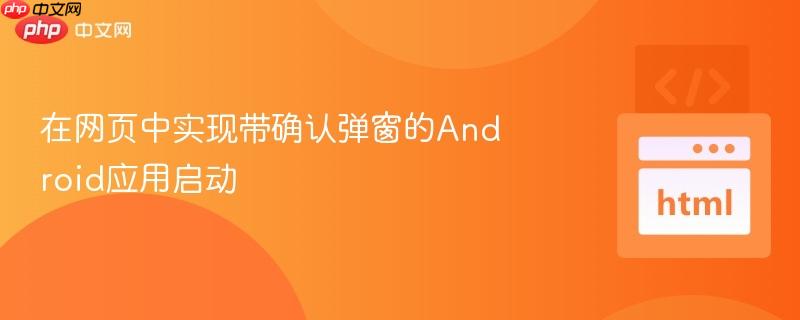
本文将详细介绍如何在网页中通过自定义确认弹窗来启动Android应用。这种方法通过在用户点击触发链接后,先展示一个模态对话框,待用户明确同意后才执行Android Intent URI跳转,从而提升用户体验并避免不必要的应用启动,确保用户操作的意图性。
在现代Web开发中,从网页启动本地移动应用(深层链接)已成为一种常见需求。然而,直接通过URI跳转可能会导致用户体验不佳,例如在用户无意点击或应用未安装时。为了提供更友好的交互,我们可以引入一个确认弹窗机制,让用户在启动应用前进行二次确认。
理解Android Intent URI深层链接
Android Intent URI是一种特殊的URL格式,允许网页向Android系统发送一个Intent,从而启动特定的应用或应用内的某个活动(Activity)。其基本格式通常为:
intent://[host][path]#Intent;scheme=[scheme];package=[package_name];action=[action];category=[category];component=[component];[extra_key]=[extra_value];end
在问题中提供的简化形式 intent://my_host#Intent;scheme=my_scheme;action=my_action; 已经足够演示基本功能。当浏览器解析到这种URI时,如果系统中有应用注册了匹配的scheme、host和action,该应用就会被启动。
实现带确认弹窗的应用启动
为了在启动应用前显示一个确认弹窗,我们需要结合HTML、CSS和JavaScript来构建一个模态对话框。
1. 构建HTML结构
首先,在您的网页中添加一个模态对话框的HTML结构。这通常包括一个覆盖层(overlay)和一个居中的对话框内容区域。
带确认弹窗的Android应用启动
从网页启动Android应用(带确认)
点击下方按钮尝试启动应用:
 传媒公司模板(RTCMS)1.0
传媒公司模板(RTCMS)1.0
传媒企业网站系统使用热腾CMS(RTCMS),根据网站板块定制的栏目,如果修改栏目,需要修改模板相应的标签。站点内容均可在后台网站基本设置中添加。全站可生成HTML,安装默认动态浏览。并可以独立设置SEO标题、关键字、描述信息。源码包中带有少量测试数据,安装时可选择演示安装或全新安装。如果全新安装,后台内容充实后,首页才能完全显示出来。(全新安装后可以删除演示数据用到的图片,目录在https://
下载
2. 添加CSS样式
为了让模态对话框正确显示和居中,我们需要一些基本的CSS样式。
/* 模态对话框样式 */
.modal-overlay {
display: none; /* 默认隐藏 */
position: fixed; /* 固定定位,覆盖整个视口 */
top: 0;
left: 0;
width: 100%;
height: 100%;
background-color: rgba(0, 0, 0, 0.6); /* 半透明背景 */
z-index: 1000; /* 确保在其他内容之上 */
display: flex; /* 使用flexbox居中内容 */
justify-content: center;
align-items: center;
}
.modal-content {
background-color: #fff;
padding: 30px;
border-radius: 8px;
box-shadow: 0 4px 12px rgba(0, 0, 0, 0.2);
max-width: 400px;
text-align: center;
animation: fadeIn 0.3s ease-out; /* 简单的淡入动画 */
}
.modal-content h2 {
color: #333;
margin-bottom: 15px;
}
.modal-content p {
color: #666;
margin-bottom: 25px;
line-height: 1.6;
}
.modal-actions button {
padding: 10px 20px;
margin: 0 10px;
border: none;
border-radius: 5px;
cursor: pointer;
font-size: 16px;
transition: background-color 0.2s ease;
}
.btn-confirm {
background-color: #007bff;
color: white;
}
.btn-confirm:hover {
background-color: #0056b3;
}
.btn-cancel {
background-color: #6c757d;
color: white;
}
.btn-cancel:hover {
background-color: #5a6268;
}
/* 淡入动画 */
@keyframes fadeIn {
from { opacity: 0; transform: translateY(-20px); }
to { opacity: 1; transform: translateY(0); }
}
/* 页面其他按钮样式 */
#openAppButton {
padding: 12px 25px;
font-size: 18px;
background-color: #28a745;
color: white;
border: none;
border-radius: 5px;
cursor: pointer;
transition: background-color 0.2s ease;
}
#openAppButton:hover {
background-color: #218838;
}3. 编写JavaScript逻辑
JavaScript将负责控制模态对话框的显示与隐藏,并在用户确认后执行Intent URI跳转。
将上述HTML、CSS和JavaScript代码整合到一个文件中,即可实现一个带有确认弹窗的Android应用启动功能。
完整示例代码
带确认弹窗的Android应用启动
从网页启动Android应用(带确认)
点击下方按钮尝试启动应用:
注意事项与最佳实践
- Intent URI的准确性: 确保您使用的androidIntentURI与您的Android应用中配置的intent-filter完全匹配。任何不匹配都可能导致应用无法启动。
-
应用未安装的场景: 当用户设备上未安装对应的Android应用时,直接通过window.location.href = androidIntentURI;跳转通常不会有任何反应,或者部分浏览器可能会尝试打开Play Store。对于更完善的用户体验,您可以考虑:
- 在确认弹窗中增加一个指向应用商店的链接,作为应用未安装时的备选方案。
- 在尝试启动应用后,设置一个短时间的延迟,如果页面没有跳转,则认为应用未启动,并显示一个下载提示。
- 用户体验: 弹窗的文案应清晰明了,告知用户将要发生的操作。弹窗的样式应与网站整体风格保持一致,提供良好的视觉体验。
- 浏览器兼容性: Intent URI在不同的浏览器和Android版本上的行为可能略有差异。在主流浏览器(如Chrome)上通常支持良好,但在某些定制浏览器或旧版本Android系统上可能存在兼容性问题。
- 安全性: 虽然通过Intent URI启动本地应用是标准行为,但在构造URI时应避免包含敏感信息或允许未经授权的操作,以防范潜在的安全风险。
- 替代方案: 对于更复杂的深层链接需求,可以考虑使用Google Play Referrer API或第三方深层链接服务(如Branch.io),它们通常提供更强大的功能,包括延迟深层链接、分析和跨平台支持。
总结
通过在网页中引入一个自定义的确认弹窗,我们能够有效地控制从Web到Android应用的跳转过程。这种方法不仅提升了用户体验,避免了意外的应用启动,也为开发者提供了一个灵活的机制来引导用户进行关键操作。掌握这一技术,可以帮助您构建更加智能和用户友好的Web应用。





























